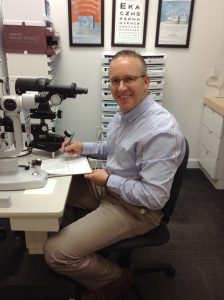
Ronnie McInnis has been with Vogue Optical for 27 years. He earned his Opticians License in 1992 and Contact Lens fitter’s license in 2011. Ron is currently engaged in the promotion and sales of contact lenses in the Sydney, Nova Scotia market.
A contact lens fitting requires a prescription that is less than a year old and about an hour of your time.
The contact lens fitter will confirm the general health of your corneas and tear film, and measure corneal curvature to determine your suitability for contact lens wear. The fitter will then discuss your work requirements and leisure activities to determine which lenses will serve you best. Contact lenses are available in many different varieties and can accommodate prescriptions for astigmatism and multifocals.
Contact lenses will be placed onto your eyes, the fit and visual acuity will be assessed, and alternate lenses chosen as required. The fitter will spend approximately 20-25 minutes discussing hygiene, wearing time, and all things necessary to safely and comfortably enjoy your new lenses. This will include insertion and removal techniques and instructions to properly clean and care for your lenses.
At this point a follow up visit will be scheduled.
Frequently Asked Questions
DOES IT HURT?
Nope. Having someone place a contact lens on your eye feels a little weird and a little wet but not painful. Relax—we’re pretty good at this.
IF I GET CONTACT LENSES, WILL I STILL NEED MY GLASSES?
Definitely. Contact lenses do not replace your glasses, as they can not be worn for all waking hours. Your fitter will discuss an appropriate wearing schedule.
ARE CONTACT LENSES SAFE?
There are risks associated with contact lens use. However, if you have your lenses fit by a licensed professional, follow proper hygiene and wearing schedules, and replace your lenses as directed, these risks become significantly reduced.
I TRIED CONTACT LENSES UNSUCCESSFULLY YEARS AGO, IS THERE ANYTHING NEW?
Yes. In recent years the contact lens industry has seen improvements in lens materials, solutions and the range of prescriptions which can be corrected with contact lenses.
IS THERE AN AGE LIMIT?
Potential contact lens patients will be considered as young as 12 years with parental consent. Patients under 16 years of age will be considered for daily disposable contact use only. There is no maximum age for contact lens use, however age-related medical conditions may significantly limit wear time.

